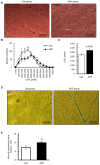Dietary Alaska Pollack Protein Induces Acute and Sustainable Skeletal Muscle Hypertrophy in Rats
- PMID: 35276908
- PMCID: PMC8837972
- DOI: 10.3390/nu14030547
Dietary Alaska Pollack Protein Induces Acute and Sustainable Skeletal Muscle Hypertrophy in Rats
Abstract
Our previous studies suggested that Alaska pollack protein (APP) intake increases skeletal muscle mass and that it may cause a slow-to-fast shift in muscle fiber type in rats fed a high-fat diet after 56 days of feeding. In this study, we explored whether dietary APP induces acute and sustainable skeletal muscle hypertrophy in rats fed a normal-fat diet. Male 5-week-old Sprague-Dawley rats were divided into four groups and fed a purified ingredient-based high-fat diet or a purified ingredient-based normal-fat diet with casein or APP, containing the same amount of crude protein. Dietary APP significantly increased gastrocnemius muscle mass (105~110%) after 2, 7 days of feeding, regardless of dietary fat content. Rats were separated into two groups and fed a normal-fat diet with casein or APP. Dietary APP significantly increased gastrocnemius muscle mass (110%) after 56 days of feeding. Dietary APP significantly increased the cross-sectional area of the gastrocnemius skeletal muscle and collagen-rich connective tissue after 7 days of feeding. It decreased the gene expression of Mstn /Myostatin, Trim63/MuRF1, and Fbxo32/atrogin-1, but not other gene expression, such as serum IGF-1 after 7 days of feeding. No differences were observed between casein and APP groups with respect to the percentage of Type I, Type IIA, and Type IIX or IIB fibers, as determined by myosin ATPase staining after 7 days of feeding. In the similar experiment, the puromycin-labeled peptides were not different between dietary casein and APP after 2 days of feeding. These results demonstrate that APP induces acute and sustainable skeletal muscle hypertrophy in rats, regardless of dietary fat content. Dietary APP, as a daily protein source, may be an approach for maintaining or increasing muscle mass.
Keywords: fish protein; muscle fiber type; protein source; rat; skeletal muscle.
Conflict of interest statement
F.K. and K.H. are former employees of Nippon Suisan Kaisha Ltd., and K.U. is a current employee of Nippon Suisan Kaisha Ltd. The funders had no role in the design of the study; in the collection, analyses, or interpretation of data; in the writing of the manuscript, or in the decision to publish the results.
Figures






Similar articles
-
Fast-twitch muscle hypertrophy partly induces lipid accumulation inhibition with Alaska pollack protein intake in rats.Biomed Res. 2010 Dec;31(6):347-52. doi: 10.2220/biomedres.31.347. Biomed Res. 2010. PMID: 21187645
-
Dietary Alaska pollack protein improves skeletal muscle weight recovery after immobilization-induced atrophy in rats.PLoS One. 2019 Jun 14;14(6):e0217917. doi: 10.1371/journal.pone.0217917. eCollection 2019. PLoS One. 2019. PMID: 31199814 Free PMC article.
-
Investigation of the Lipid Changes That Occur in Hypertrophic Muscle due to Fish Protein-feeding Using Mass Spectrometry Imaging.J Oleo Sci. 2019;68(2):141-148. doi: 10.5650/jos.ess18193. J Oleo Sci. 2019. PMID: 30713267
-
Fish Protein Promotes Skeletal Muscle Hypertrophy via the Akt/mTOR Signaling Pathways.J Nutr Sci Vitaminol (Tokyo). 2022;68(1):23-31. doi: 10.3177/jnsv.68.23. J Nutr Sci Vitaminol (Tokyo). 2022. PMID: 35228492
-
Alaska pollack protein prevents the accumulation of visceral fat in rats fed a high fat diet.J Nutr Sci Vitaminol (Tokyo). 2009 Apr;55(2):156-61. doi: 10.3177/jnsv.55.156. J Nutr Sci Vitaminol (Tokyo). 2009. PMID: 19436142
Cited by
-
Chronic Intake of a Meal Including Alaska Pollack Protein Increases Skeletal Muscle Mass and Strength in Healthy Older Women: A Double-Blind Randomized Controlled Trial.J Nutr. 2023 Jan 14;152(12):2761-2770. doi: 10.1093/jn/nxac219. J Nutr. 2023. PMID: 36138493 Free PMC article. Clinical Trial.
-
Water-soluble protein from walleye pollock (Gadus chalcogrammus) suppresses lipopolysaccharide-induced inflammation by attenuating TLR4-MyD88 expression in macrophages.Food Chem (Oxf). 2023 Feb 6;6:100165. doi: 10.1016/j.fochms.2023.100165. eCollection 2023 Jul 30. Food Chem (Oxf). 2023. PMID: 36891454 Free PMC article.
-
A Cell-Based Assessment of the Muscle Anabolic Potential of Blue Whiting (Micromesistius poutassou) Protein Hydrolysates.Int J Mol Sci. 2023 Jan 19;24(3):2001. doi: 10.3390/ijms24032001. Int J Mol Sci. 2023. PMID: 36768324 Free PMC article.
References
MeSH terms
Substances
Grants and funding
LinkOut - more resources
Full Text Sources
Medical
Miscellaneous

